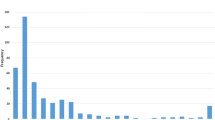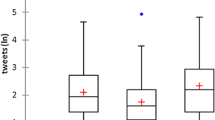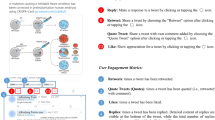Abstract
The purpose of this paper was to examine the presence of scholarly book publishers on Twitter, and tweets about books in 10 SSH disciplines (2014–2018). This included time of tweet relative to the book's publication date and time span of twitter activity. We also investigated the ‘categories of conversation' in publisher tweets, with a focus on hashtags and @-mentions. Data collection involved matching 15,454 unique book titles from the BKCI-Web of Science with tweets retrieved from Altmetrics.com, using ISBNs. This led to a working dataset of n = 6258 books (41%), which had received at least one tweet. Our analyses show that scholarly publishers have been using Twitter more and more over a 5 year period, especially commerical publishers. Commercial publishers are more likely than university presses to have multiple Twitter accounts. Both, though mainly commercial publishers, are active at targeting the Twitter accounts of book authors, book editors, other individuals and universities/institutions/organisations. Whilst re-tweets do not often follow first, or ‘initiator' tweets made by publishers, publisher engagement in general corresponds significantly with other tweets, and contributes to keeping the book active for a longer period on Twitter. Publishers play a key role as promotional agents, particularly when a scholarly title is part of a special offer, relevant to a conference, event or special calendar date, when an author is a prize winner, or if author-agreements have been made in regards to open access book chapters.













Similar content being viewed by others
References
Abbott, C. (2009). To Tweet or not to Tweet: twitter basics for publishers and authors: Promoting books in 140 characters or less. Publishers Weekly, 256(13). Retrieved November 26, 2018 from http://www.publishersweekly.com/pw/print/20090330/2722-to-tweet-or-not-to-tweet-twitter-basics-for-publishers-and-authors-.html.
Alperin, J. P., Gomez, C. J., & Haustein, S. (2018). Identifying diffusion patterns of research articles on Twitter: A case study of online engagement with open access articles. Public Understanding of Science. https://doi.org/10.1177/0963662518761733.
Bowman, T. D. (2015). Differences in personal and professional tweets of scholars. Aslib Journal of Information Management, 67(3), 356–371. https://doi.org/10.1108/AJIM-12-2014-0180.
Boyd, D., Golder, S., & Lotan, G. (2010). Tweet, tweet, retweet: Conversational aspects of retweeting on Twitter. In Proceedings of the 43rd Hawaii international conference on system sciences 2010. Retrieved March 1, 2011 from http://www.danah.org/papers/TweetTweetRetweet.pdf.
Bruns, A., & Moe, H. (2014). Structural layers of communication on Twitter. In K. Weller, A. Bruns, J. Burgess, M. Mahrt, & C. Puschmann (Eds.), Twitter and society (pp. 15–28). New York: Peter Lang.
Costas, R. van Honk, J. & Franssen, T. (2017). Scholars on Twitter: Who and how many are they? In Proceedings of the 16th International Conference on Scientometrics and Informetrics (pp. 224–235). Wuhan University: Wuhan, China. Available at: arXiv:1712.05667v1.
Darling, E. S., Shiffman, D., Côté, I., & Drew, J. A. (2013). The role of Twitter in the life cycle of a scientific publication. Ideas in Ecology and Evolution, 6, 32–43. https://doi.org/10.7287/peerj.preprints.16v1.
Didegah, F., Bowman, T. D., Bowman, S., & Hartley, J. (2016). Comparing the characteristics of highly cited titles and highly alted titles. In 21st International Conference on Science and Technology Indicators (pp. 1190–1195). Valencia, Spain. Retrieved from http://ocs.editorial.upv.es/index.php/STI2016/STI2016/paper/viewFile/4543/2327.
Didegah, F., Mejlgaard, N., & Sørensen, M. P. (2018). Investigating the quality of interactions and public engagement around scientific papers on Twitter. Journal of informetrics, 12(3), 960–971.
ENRESSH. (2019). Academic book publishers (ABP): A global and multilingual register. Available at: https://enressh.eu/wp-content/uploads/2019/08/Academic-Book-Publishers-ABP-A-global-and-interactive-register.pdf.
Fang, Z., Costas, R., Tian, W., Wang, X., & Wouters, P. (2020). An extensive analysis of the presence of altmetric data for Web of Science publications across subject fields and research topics. Scientometrics, 124, 2519–2549. https://doi.org/10.1007/s11192-020-03564-9.
Giménez-Toledo, E., Mañana-Rodríguez, J., & Tejada-Artigas, C.-M. (2015). Scholarly publishers indicators: Prestige, specialization and peer review of scholarly book publishers. El profesional de la información, 24(6), 855–860. https://doi.org/10.3145/epi.2015.nov.18.
Giménez-Toledo, E., Sivertsen, G., & Ma.ana-Rodr.guez, J. (2019). International Register of Academic Book Publishers (IRAP): Overview, current state and future challenges. In H. F. Moed, C. Daraio, G. Catalano & G. Ruocco (Eds,), Proceedings of the International Society for Scientometrics (ISSI) Conference (pp. 1752–1757). Rome, Italy: September 2–5.
Gorraiz, J., Melero-Fuentes, D., Gumpenberger, C., & Valerrama-Zurián, J. (2016). Availability of digital object identifiers (DOIs) in Web of Science and Scopus. Journal of Informetrics, 10(1), 98–109.
Guns, R. (2018). Concentration of academic book publishers. In STI 2018 Conference Proceedings (pp. 518–525). Available at : https://openaccess.leidenuniv.nl/handle/1887/65268.
Hammarfelt, B. (2014). Using altmetrics for assessing research impact in the humanities. Scientometrics, 101(2), 1419–1430. https://doi.org/10.1007/s11192-014-1261-3.
Hassan, S.-U., et al. (2017). Measuring social media activity of scientific literature: An exhaustive comparison of scopus and novel altmetrics big data. Scientometrics, 113(2), 1037–1057.
Haustein, S. (2016). Grand challenges in altmetrics: Heterogeneity, data quality and dependencies. Scientometrics, 108(1), 413–423.
Haustein, S., et al. (2019). Scholarly Twitter metrics. In W. Glanzel, H. F. Moed, & U. Schmoch (Eds.), Handbook of quantitative science and technology research. (pp. 729–760). Springer.
Haustein, S., Bowman, T. D., Holmberg, K., Peters, I., & Larivière, V. (2014). Astrophysicists on Twitter: An in-depth analysis of tweeting and scientific publication behavior. Aslib Journal of Information Management, 66(3), 279–296. https://doi.org/10.1108/AJIM-09-2013-0081.
Haustein, S., Costas, R., & Larivière, V. (2015). Characterizing social media metrics of scholarly papers: The effect of document properties and collaboration patterns. PLoS ONE, 10(3), e0120495. https://doi.org/10.1371/journal.pone.0120495.
Haustein, S., Peters, I., Sugimoto, C. R., Thelwall, M., & Larivière, V. (2013). Tweeting biomedicine: An analysis of tweets and citations in the biomedical literature. Journal of the American Society for Information Science and Technology, 65(4), 656–669. https://doi.org/10.1002/asi.23101.
Holmberg, K., & Thelwall, M. (2014). Disciplinary differences in Twitter scholarly communication. Scientometrics, 101, 1027–1042. https://doi.org/10.1007/s11192-014-1229-3.
Holmberg, K., & Vainio, J. (2018). Why do some research articles receive more online attention and higher altmetrics? Reasons for online success according to the authors. Scientometrics, 116, 435–447. https://doi.org/10.1007/s11192-018-2710-1.
Ke, Q., Ahn, Y.-Y., & Sugimoto, C. R. (2017). A systematic identification and analysis of scientists on Twitter. PLoS ONE, 12(4), e0175368. https://doi.org/10.1371/journal.pone.0175368.
Konkiel, S. & Addie, E. (2018). What altmetrics can tell us about the "real world" impacts of books. Available at https://figshare.com/articles/online_resource/What_altmetrics_can_tell_us_about_the_real_world_impacts_of_books/6940325.
Kousha, K., Thelwall, M., & Abdoli, S. (2017). Goodreads reviews to assess the wider impacts of books. Journal of the Association for Information Science and Technology, 68(8), 2004–2016.
Kulczycki, E., Rozkosz, E. A., Engels, T. C. E., Guns, R., Hołowiecki, M., & Pölönen, J. (2019). How to identify peer-reviewed publications: Open-identity labels in scholarly book publishing. PLoS ONE, 14(3), e0214423. https://doi.org/10.1371/journal.pone.0214423.
Larivière, V., Haustein, S., & Mongeon, P. (2015). The Oligopoly of academic publishers in the digital era. PLoS ONE, 10(6), e0127502. https://doi.org/10.1371/journal.pone.0127502.
Larivière, V. & Alperin, J. P. (12 July 2018). Altmetrics Blog. “Not sure if scientist or just Twitter bot” Or: Who tweets about scholarly papers. Retrieved May 27, 2020 from https://www.altmetric.com/blog/not-sure-if-scientist-or-just-twitter-bot-or-who-tweets-about-scholarly-papers/
Mannana-Rodriguez, J., & Giménez-Toledo, E. (2018). Specialization and multidisciplinarity of scholarly book publishers: Differences between Spanish University Presses and other scholarly publishers. Scientometrics, 114(1), 19–30. doi:https://doi.org/10.1007/s11192-017-2563-z.
Routledge (2020). Open Access books. Publishing Open Access Books: Chapters. Retrieved from https://www.routledge.com/our-products/open-access-books/publishing-oa-books/chapters.
Robinson-Garcia, N., Costas, R., Isett, K., Melkers, J., & Hicks, D. (2017). The unbearable emptiness of tweeting—about journal articles. PLoS ONE, 12(8), 1–19. https://doi.org/10.1371/journal.pone.0183551.
Sugimoto, C. R., Work, S., Larivière, V., & Haustein, S. (2017). Scholarly use of social media and altmetrics: A review of the literature. Journal of the Association for Information Science and Technology, 68(9), 2037–2062. https://doi.org/10.1002/asi.23833.
The Balance Careers (2019). The big 5 trade book publishers. Retrieved November 29 2019 from https://www.thebalancecareers.com/the-big-five-trade-book-publishers-2800047.
Thoring, A. (2011). Corporate Tweeting: Analysing the use of Twitter as a Marketing Tool by UK Trade Publishers. Publishing Research Quarterly, 27(2), 141–158. https://doi.org/10.1007/s12109-011-9214-7.
Tsou, A., Bowman, T., Ghazinejad, A., & Sugimoto, C. R. (2015). Who tweets about science? In Proceedings of the 15th Conference of the International Society for Scientometrics and Informetrics (pp. 95–100). Istanbul, Turkey: Boğaziçi University Printhouse. Available at: http://www.issi-society.org/proceedings/issi_2015/0095.pdf
Torres-Salinas, D., & Moed, H. F. (2009). Library catalog analysis as a tool in studies of social sciences and humanities: An exploratory study of published book titles in economics. Journal of Informetrics, 3(1), 9–26.
Torres-Salinas, D., Gumpenberger, C., & Gorraiz, J. (2017). PlumX as a potential tool to assess the macroscopic multidimensional impact of books. Frontiers in Research Metrics and Analytics, 2(5), 1–11. https://doi.org/10.3389/frma.2017.00005.
Torres-Salinas, D., Gorraiz, J. & Robinson-Garcia, N. (2018). The insoluble problems of books: What does Altmetric.com have to offer? Aslib Journal of Information Management, 70(6), 691–707.
Torres-Salinas, D., Robinson-Garcia, N., & Gorraiz, J. (2017). Filling the citation gap: Measuring the multidimensional impact of the academic book at institutional level with PlumX. Scientometrics, 113(3), 1371–1384.
Verleysen, F. T., & Engels, T. C. E. (2014). A label for peer-reviewed books. Journal of the Association for Information Science and Technology, 64(2), 428–430.
White, H., Boell, S. K., Yu, H., Davis, M., Wilson, C. S., & Cole, F. T. H. (2009). Libcitations: A measure for comparative assessment of book publications in the humanities and social sciences. Journal of the American Society for Information Science and Technology, 60(6), 1083–1096.
White, H., & Zuccala, A. (2018). Libcitations, WorldCat, cultural impact, and fame. Journal of the Association for Information Science and Technology, 69(12), 1502–1512.
Zedda, M., & Barbaro, A. (2015). Adoption of Web 2.0 tools among STM publishers. How social are scientific journals? Journal of the European Association for Health Information and Libraries, 11(1), 9–12.
Zuccala, A., & Cornacchia, R. (2016). Data matching, integration, and interoperability for a metric assessment of monographs. Scientometrics, 108(1), 465–484.
Zuccala, A., Guns, R., Cornacchia, R., & Bod, R. (2014). Can we rank scholarly book publishers? A bibliometric experiment with the field of history. Journal of the Association for Information Science and Technology, 66(7), 1333–1347.
Zuccala, A., Pölönen, J., Guns, R., Røeggen, V., Kulczycki, E., Bruun, K. & Savolainen, E. (2021). Performance-based publisher ratings and the visibility/impact of books: Small fish in a big pond, or big fish in a small pond? Quantitative Studies of Science (in press).
Zuccala, A., & Robinson-Garcia, N. (2019). Reviewing, indicating and counting books for modern research evaluation systems. In W. Glanzel, H. Moed, U. Schmoch, & M. Thelwall (Eds.), Handbook of science and technology indicators. (pp. 715–728). Cham: Springer.
Author information
Authors and Affiliations
Corresponding author
Rights and permissions
About this article
Cite this article
Wang, Y., Zuccala, A. Scholarly book publishers as publicity agents for SSH titles on Twitter. Scientometrics 126, 4817–4840 (2021). https://doi.org/10.1007/s11192-021-03947-6
Received:
Accepted:
Published:
Issue Date:
DOI: https://doi.org/10.1007/s11192-021-03947-6




